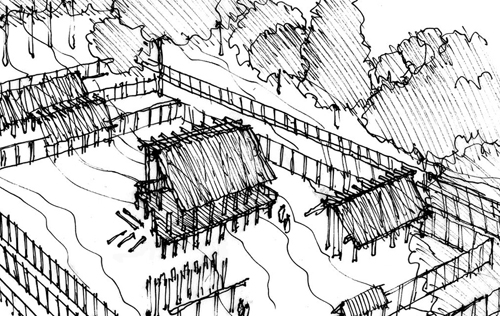According to economists at National Association of Home Builders, first-time home buyers are "contributing to an increase in demand for smaller and less expensive homes." It is reported that design of the home is the single most important factor for 36% of them.
First-time buyers are not compromising on the quality, but are willing to down-size. To me, letting go of the notion that bigger is better seems like a step in the right direction.
I consider attributes such as pure, clean, and spirited to be the highest praise when it comes to describing a building or a space within it. Simple is beautiful. On the brink of foreclosure, this mantra serves me. Professionally as well as personally, I can strive to appreciate what I have and make the most of it. To me, it's not the same as being satisfied with less.
The Ise (Ise-jingū), a Shinto shrine in the forest of sacred Japanese cypress trees that is destroyed every 20 years and replaced by exact duplicate built on the adjacent site comes to mind. Despite of the effort and numerous rituals that it takes to build, it is not too precious to demolish and rebuild anew.

The Ise Shrine: Deconstruction. Sketch by Miller Yee Fong, Architect
Permanence in Renewal
The Ise shrine complex consists of two major sanctuaries, which are located about four miles apart. The main building at each shrine is a simple thatched hut made of unpainted cypress wood in ancient Japanese style.
The rebuilding program commences twelve years after the completion of the preceding program, as it is eight years long. It is accompanied by 32 rituals. The newly constructed buildings are supposed to be exact copies of the old structures.
After the new shrines have been authenticated by the priests, the old shrines are torn down and the lumber is given to the tributary shrines throughout Japan. Once a shrine building is deconstructed, white pebbles are strewn across the site and a single post about seven feet high is erected in the center with a tiny wooden hut (oi-ya) enclosing it. The site remains sacred for the next 20 years, when it will host the shrine again.
This tradition goes back to the 7th century and has been performed regularly ever since. In 1926, a reforestation program was introduced in order to ensure enough Japanese cypress wood for the next 200 years. The last reconstruction ceremonies (the 61st to be held) took place on October 2 (Inner Shrine) and October 5 (Outer Shrine) of 1993.
"Live-by-Design" Connection
What do first-time home buyers, the Ise Shrine and the rest of us have in common? I'd like to point out that we might share a similar approach to certain constraints. We choose not to be stuck; therefore, we find a way to make the most of what we have. We aim for renewal, purity and simplicity. By being open-minded, we practice self-forgiveness.
A shrine was destroyed every 20 years and replaced by exact duplicate in order to conquer time through the art of renewal. In my own life, I can address the need to let go by focusing on the essential. I can decide to stop regretting the past. I can decide to endure living in the moment on a daily basis. I can say:
"I don't hate myself for taking so long to act and for getting side-tracked. I believe that I can do what is necessary and I will do it."
You do no harm. You consume everything in moderation. You are willing to be true to yourself in everything you do. You exercise patience. You do not rise to the bait. You do the right thing whether or not anyone is watching. You do not dwell on regrets. When it comes to letting go, what do you say?
